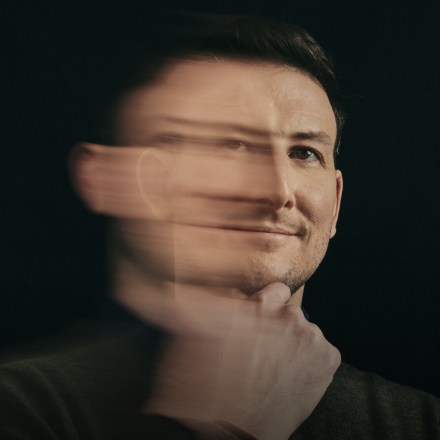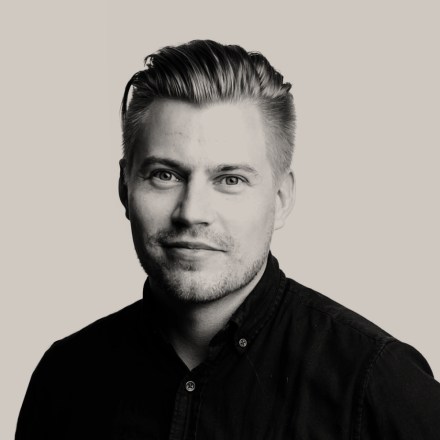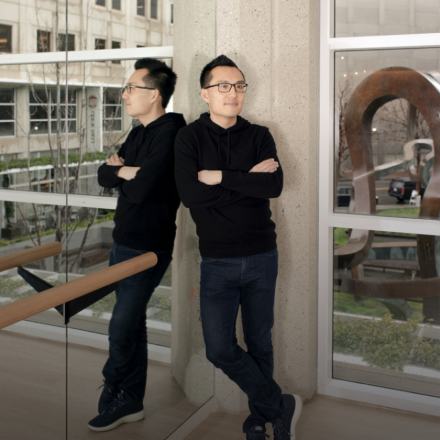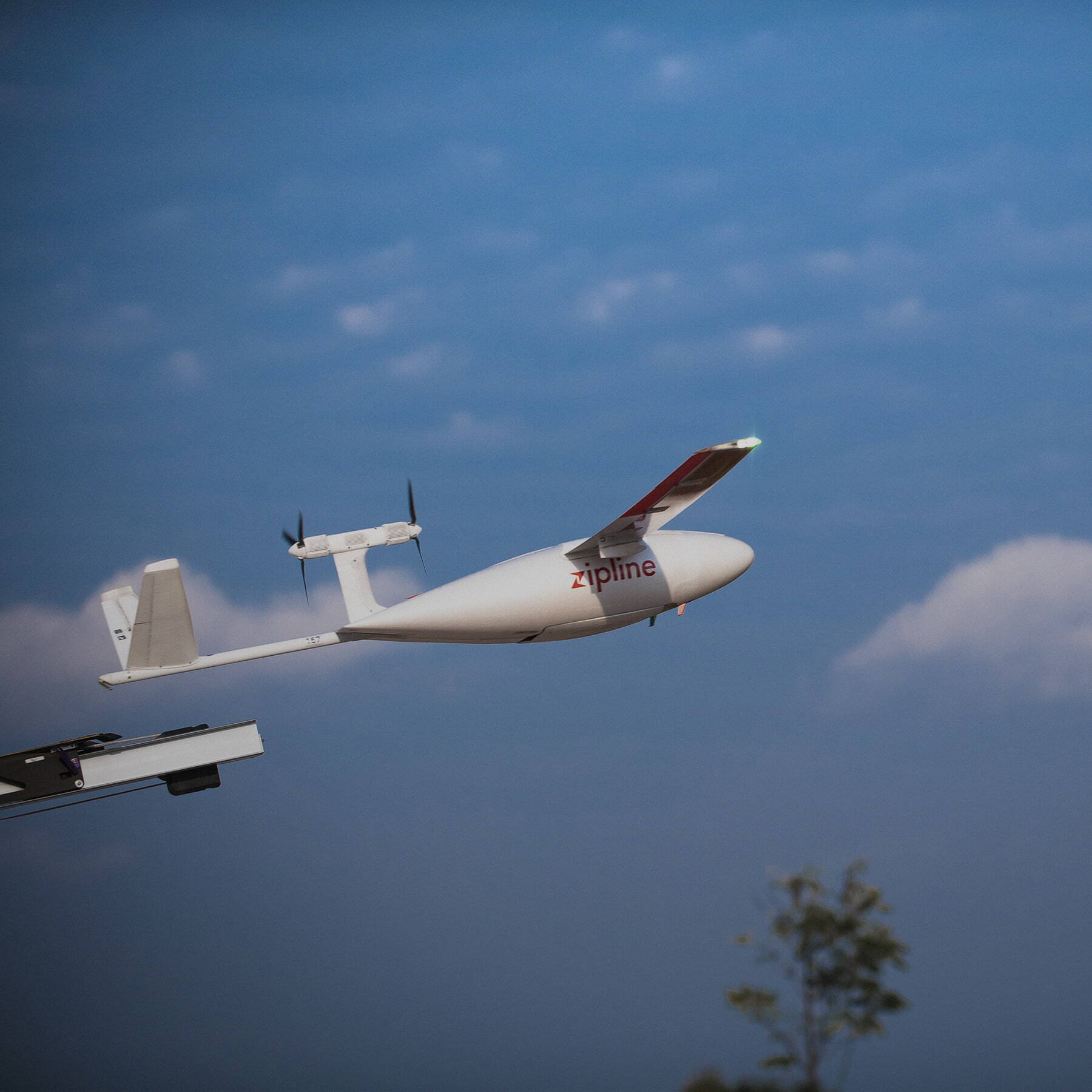
Zipline’s Stratospheric Strategy to Drop the World in Your Backyard
Still, dry air hangs over my head and the hum of power generators and insects fills my ears. Under a small tent in the middle of an empty field, white foam drones with bright red wings, each about the size of a pony, rest in racks next to rows of heavy-duty batteries glowing with digital lights. One of these contraptions will soon launch into the sky, propelled aloft by a catapult-like device. I watch, enraptured, as it floats against an electric blue backdrop, sitting somewhere in my mental schema between a toy airplane and an eagle stalking a mouse.
This is Zipline, a startup whose backers believe is the future of logistics. For them, the drone itself represents only the immediate physical manifestation of a vast network of connected sensors, software, machine learning algorithms and other technical wizardry. This largely automated infrastructure keeps Zipline’s fleet collectively flying the equivalent of the length of the equator every 12 hours. The drones deliver blood, covid-19 vaccines, vital medical supplies and other goods to people on three continents. Zipline is not trying to compete against the buzzy quad-copters that millions of tech-savvy teens salivate over. It is instead taking on something far more deeply entrenched in our modern economic landscape: the delivery truck.
“We had a pretty good sense that somebody was going to design an electric autonomous delivery system for the planet. It would would allow humanity to move stuff around as quickly and efficiently as the internet moves information.”
KELLER RINAUDO
Zipline was founded by Keller Rinaudo, an Arizona-raised entrepreneur whose foray into the Silicon Valley startup world reads like a how-to manual for dazzling reinvention. “In 2013, when we started building what ultimately became Zipline, we had a pretty good sense that somebody was going to design an electric autonomous delivery system for the planet,” Rinaudo tells me during a visit to the firm’s South San Francisco headquarters and manufacturing facility. “It was going to be a transformational thing that would allow humanity to move stuff around as quickly and efficiently as the internet moves information.”
The company is now working to become that system, partnering with giants like Walmart, Toyota and Pfizer to shrink the distance between a parcel and the person who needs it. It is a trick approaching teleportation: Zipline can deliver goods in as little as 15 to 45 minutes anywhere within a 50-mile radius of their distribution centers. With supply chains still languishing in a pandemic-induced hangover, Zipline aims to inject newfound energy into logistics, a space still depressingly dependent on inefficient rubber, road and combustion engines.
Between a rock and a hard place
Tracing the arc of Rinaudo’s life from childhood to Zipline highlights the combination of gut instinct and dogged determination that often underlies success, especially in cutthroat sectors like technology. A self-described “geeky kid” who “had no idea what I wanted to do” as a teenager, in high school Rinaudo founded a debate magazine and worked in a restaurant stocking a refrigerator. These activities gave him crucial experience managing people and projects and a sense of empowerment amid an otherwise tough environment. “My school was predominantly gangs and drug dealers,” he says. “I was not particularly outgoing and always being made fun of for how short I was. It was a pretty depressing place.”
Rinaudo applied to Harvard at the last minute, drafting his personal essay over the course of a single night. “The essay was about my grandfather who was dying of cancer,” he says. “I wrote it from midnight to three a.m., printed it out and put it in the mail the next morning.” He concedes he was shocked to be admitted—a reaction that made him all the more determined to take advantage of the opportunities Harvard provided. While there, two tracks occupied his time. The first was a lab attempting to make computers out of DNA. The second was rock climbing.
“Over the summer after my freshman year, I built a rock-climbing wall at the university without the approval—or even the awareness—of the administration,” he says, telling me a tale of marathon fundraising and rapid implementation that was clearly an early indication of his entrepreneurial nous. “It was Harvard’s first climbing wall and lives on to this day, and we bootstrapped it from nothing—it was a really magical experience.”
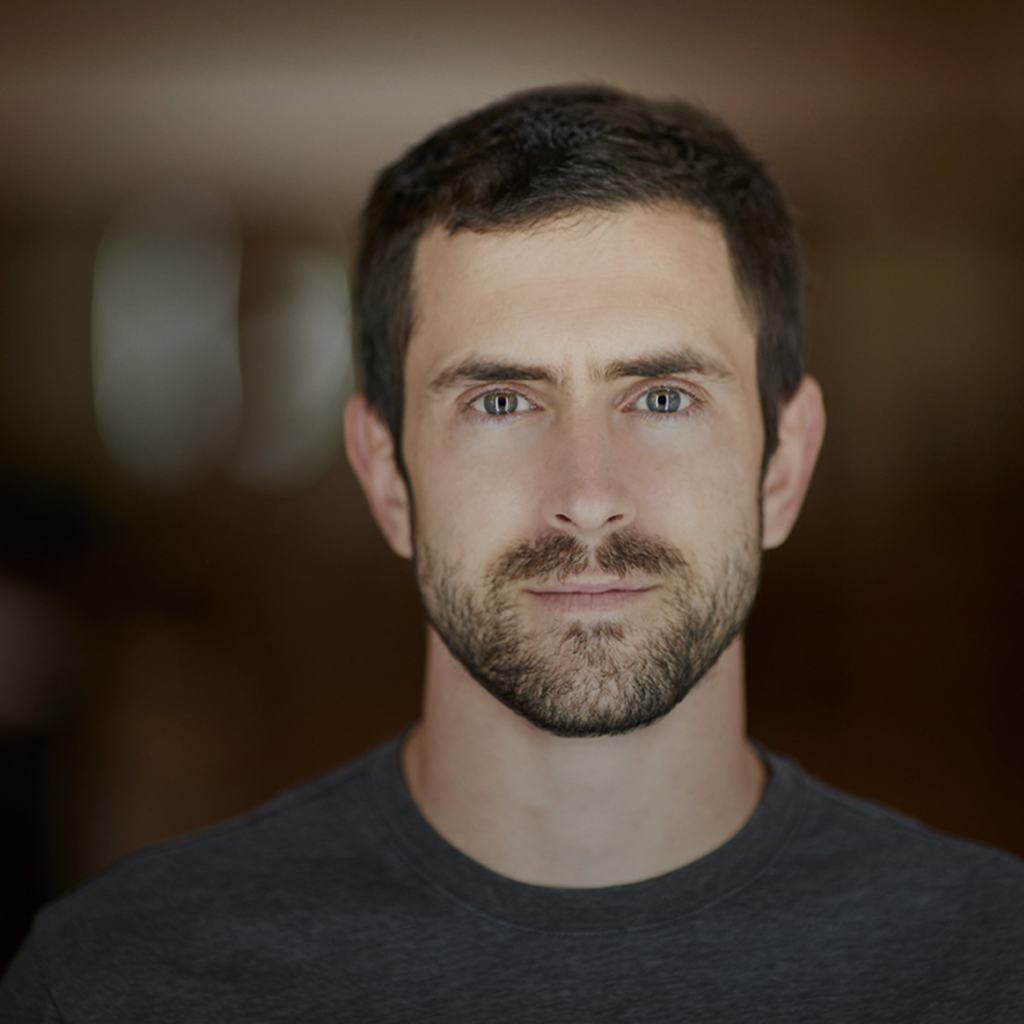
Rock climbing would prove so pivotal to Rinaudo’s early days that he spent several years after graduation pursuing it professionally, gradually achieving a level of national prominence in the sport. “I was pretty happy, just living in a Honda Fit and driving around the country,” he says. “I realized I can be very happy on very little—this is probably one reason I’m not a risk averse person.”
Get the best stories from the Sequoia community.
Permission to launch
Within a few years, Rinaudo ended his sojourn into rock-climbing in order to focus full-time on science and company-building. Brainstorming career shifts with friends and former classmates, he eventually founded Romotive, a startup that turned a smartphone into a child’s toy by plugging it into a small mechanical car. The organization scored an early win after Rinaudo reached out to Zappos founder Tony Hsieh and found him an unexpectedly enthusiastic backer, inviting Rinaudo to stay in one of his Las Vegas apartments and exchange ideas over regularly scheduled walks. More investment money followed, including from Sequoia—despite the fact that Rinaudo soon started to question Romotive’s mission and pathway to success. He describes growing uneasy over what he saw as the disposable, kitschy nature of most home robots—the kind of product that is often used for a few months and then thrown into a closet.
“The more I thought about it, the harder it was to justify expending my energy on a consumer robotics product that probably wasn’t going to work that well,” he admits. “Robots in the home are a notoriously tough space to crack, and I felt that there were bigger problems I wanted to solve, bigger questions I wanted to answer. There is a joke in robotics that once a robot works and does something well, you don’t call it a robot anymore—you just call it the thing that it does, like a dishwasher. I didn’t see us getting to that place with Romotive.”
“The more I thought about it, the harder it was to justify expending my energy on a consumer robotics product. I felt that there were bigger problems I wanted to solve, bigger questions I wanted to answer.”
KELLER RINAUDO
Rinaudo connected with robotics expert Keenan Wyrobek, and together they sought a “really important, repeatable problem that can be solved with automation,” in Rinaudo’s words. In 2014, Rinaudo took a trip to Tanzania to investigate a budding thesis about the ability to improve on existing medical logistics methods. He visited a warehouse storing healthcare products, and discovered boxes of medical supplies languishing because they couldn’t be distributed fast enough. “The more we learned, the more it became clear to us that logistics was a really good place to focus,” Rinaudo says.
The next several months proved a difficult time, however, as Rinaudo transformed Romotive into Zipline, suffering through waves of turmoil with investors and staff alike. “We had to lay off half, two-thirds of the team,” he says. “I remember meeting [Sequoia partner] Alfred Lin in a San Francisco bar and he straight-up asked, ‘So is this how you thought it would end?’ It was a pretty scary time.”
Gaining altitude
Lin recalls his own jitters: to him, the only thing scarier than starting afresh with Zipline was continuing down Romotive’s current path. “We needed a sharp pivot—a hail mary move,” he says. In 2016, Rwanda became Zipline’s first market. Combining a challenging medical logistics environment with a government open to innovation, it proved the perfect environment for the kind of customer-centric development Rinaudo envisioned.
Still, bridging the gap between a renewed mission for his company and a full-fledged business soon became a series of high-stress ordeals. Zipline’s first few months in Rwanda tested Rinaudo’s derring-do against not only manufacturing and technology hurdles, but the need to build trust in a market halfway around the world. The tension was particularly acute in the space Zipline entered initially: medical goods, specifically blood for postnatal women.
Gatare Swaibu, head of Rwanda’s biomedical services department under its Ministry of Health, readily admits to the skepticism about Zipline’s early work in the country. “People genuinely thought it could not work,” he says. Plowing ahead in this untested space, Zipline skirted the line of failure several times in its early deployment, refining hardware, software, and procedures as they learned from real operational challenges. “We endured months of sleepless nights,” Rinaudo recalls. “When we started, we said we would serve 21 hospitals, but it was a huge challenge to make it work for just one. We ended up serving that one hospital for the entire first nine months.”
Paul Willard, an early backer and advisor, describes a particularly nerve-wracking episode from September 2016, when Zipline’s public debut in Rwanda came close to failure. The country’s president Paul Kagame was on hand to push the launch button and unveil the company to the world. The night before launch, however, the system nearly broke down, Willard recalls. “The team sprinted to fix it,” he says. “I don’t think Keller even had time to shower before the press conference.”
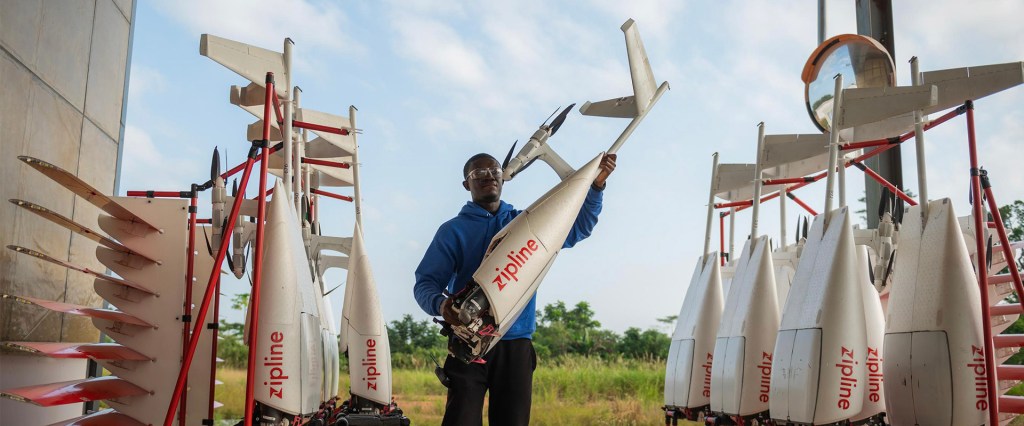
Rinaudo credits Rwanda’s health system for its patience and long-term vision. After those first nine months, “the clouds parted,” he recalls. “We added hospital after hospital. By the end of the first year we were serving 20.” Today, Zipline reaches nearly 3,000 hospitals and health centers across Rwanda and Ghana.
The statistics about Zipline’s impact in Rwanda—thousands of lives saved, a huge amount of suffering averted—now undergird the company’s push to expand its operations in other global markets, including Japan, Nigeria and the U.S. Despite Zipline’s worldwide traction, Rinaudo continues to embody a kind of scrappy style that has been vital to Zipline’s success. “A lot of drones emerge from incubators where people spend years refining the product before bringing it to market,” he says. “We wanted, as much as possible, to learn directly from customers.”
Rinaudo notes that this process convinced him to focus on two factors above all else: cost and range. This leads to a nimble, hyper-streamlined look in Zipline’s drones—the battery, for example, doubles as the brain, collecting granular and minute data on every twist and turn—and a minimalist, bare-bones style in its facilities as a whole. This approach prioritizes reliability and results over style and makes for a less photogenic product than many drones in the public imagination. Yet when the goal is to conquer the global logistics industry—especially the excruciatingly difficult last-mile stretch—much of the flashy hype around drones can suddenly feel like nothing more than window dressing.
Reflecting on the transformative potential of drones, Rinaudo muses, “Why are there all these broken promises and all this vaporware?” He positions Zipline as the antidote to the “shiny object” syndrome afflicting the drone universe: a company committed to mastering the myriad details that go into creating an airborne logistics system for the planet.
Sequoia’s Lin agrees, conjuring up a Zipline-powered future that sees the asphalt-bound wheels of the ant-like delivery trucks plying the world’s streets lifted, Inception-esque, into the sky. “Why do we do delivery in two dimensions when we could do it in three?” Lin asks rhetorically. “Every rooftop should be a mailroom.”
“Why do we do delivery in two dimensions when we could do it in three? Every rooftop should be a mailroom.”
ALFRED LIN
Belaying a grand narrative
Rinaudo may seem an unlikely person to bring such a radical prospect to life; in our conversations he comes off as a jack-of-all-trades who readily admits that the twists and turns of his life and career have caught even him by surprise. “A lot of entrepreneurs create this ‘perfect’ founding story about how everything in their life led to this moment,” he says. “That’s largely manufactured hype.”
Willard, however, pinpoints the quality in Rinaudo that he sees as instrumental in shepherding Zipline to its current juncture. “Keller is a master of ‘servant leadership’,” he says. “This entails letting big decisions be made by those closest to the ultimate impact, and then enabling and feeding and fueling those people to make those decisions.”
This concept provides a clarifying backdrop for Rinaudo’s rise. The grand heroic narrative that many founders embrace is often, at its core, nothing more than smoke and mirrors. The truth is usually far messier: a series of serendipitous stumbles and recoveries, of constant trial and error in which learning from others is just as important as imposing one’s will from on-high. “A big part of rock climbing is failing 100 times to succeed once,” Rinaudo says. “You approach the same cliff day after day, do the same moves and stumble over and over. Slowly you iterate, evolve and get better. Then one day you just show up, strap on your gloves and conquer the mountain.”
